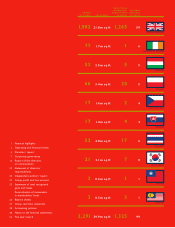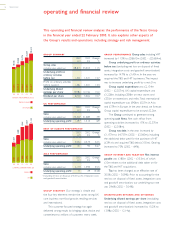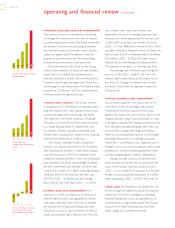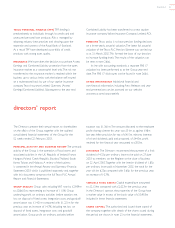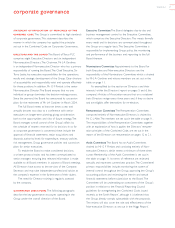Tesco 2003 Annual Report Download - page 9
Download and view the complete annual report
Please find page 9 of the 2003 Tesco annual report below. You can navigate through the pages in the report by either clicking on the pages listed below, or by using the keyword search tool below to find specific information within the annual report.
TESCO PLC 7
STATEMENT OF APPLICATION OF PRINCIPLES OF THE
COMBINED CODE The Group is committed to high standards
of corporate governance.This statement describes the
manner in which the company has applied the principles
set out in the Combined Code on Corporate Governance.
DIRECTORS AND THE BOARD The Board of Tesco PLC
comprises eight Executive Directors and six independent
Non-executive Directors.The Chairman, Mr J A Gardiner,
is an independent Non-executive Director who has a primary
responsibility of running the Board.The Chief Executive, Sir
Terry Leahy, has executive responsibilities for the operations,
results and strategic development of the Group. Clear divisions
of accountability and responsibility exist and operate effectively
for these positions. In addition, Mr G F Pimlott is the senior
Non-executive Director. The Board ensures that no one
individual or group dominates the decision-making process.
Since the year-end, the Board has announced its succession
plans for the retirement of Mr J A Gardiner in March 2004.
The full Board meets at least ten times a year and
annually devotes two days to a conference with senior
executives on longer-term planning, giving consideration
both to the opportunities and risks of future strategy. The
Board manages overall control of the Group’s affairs by
the schedule of matters reserved for its decision. In so far
as corporate governance is concerned, these include the
approval of financial statements, major acquisitions and
disposals, authority levels for expenditure, treasury policies,
risk management, Group governance policies and succession
plans for senior executives.
To enable the Board to make considered decisions,
a written protocol exists and has been communicated to
senior managers ensuring that relevant information is made
available to all Board members in advance of Board meetings.
All Directors have access to the services of the Company
Secretary and may take independent professional advice at
the company’s expense in the furtherance of their duties.
The need for Director training is regularly assessed
by the company.
GOVERNANCE STRUCTURES The following paragraphs
describe the key governance structures operating in the
Group under the overall direction of the Board.
Executive Committee The Board delegates day-to-day and
business management control to the Executive Committee,
which comprises the Executive Directors. This meets formally
every week and its decisions are communicated throughout
the Group on a regular basis.The Executive Committee is
responsible for implementing Group policy, the monitoring
and performance of the business and reporting to the full
Board thereon.
Nominations Committee Appointments to the Board for
both Executive and Non-executive Directors are the
responsibility of the Nominations Committee which is chaired
by Mr J A Gardiner and whose members are set out in the
table on page 11.
As exemplified by the section on ‘Directors and their
interests’within the Directors’report on pages 5 and 6, the
company’s Articles of Association ensure that on a rotational
basis Directors resign every three years and, if they so desire
and are eligible, offer themselves for re-election.
Remuneration Committee The Remuneration Committee,
composed entirely of Non-executive Directors, is chaired by
Mr C L Allen.The members are set out in the table on page 11.
The responsibilities of the Remuneration Committee, together
with an explanation of how it applies the Directors’remuner-
ation principles of the Combined Code, are set out in the
report of the Directors on remuneration on pages 12 to 21.
Audit Committee The Board has an Audit Committee,
chaired by Mr G F Pimlott and consisting entirely of Non-
executive Directors, which meets a minimum of three times
a year. Membership of the Audit Committee is set out in
the table on page 11. Its terms of reference are reviewed
annually and represent current best practice.The Committee’s
primary responsibilities include monitoring the system of
internal control throughout the Group, approving the Group’s
accounting policies and reviewing the interim and annual
financial statements before submission to the Board.The
Committee will be undertaking an assessment of the Group’s
position in relation to the Financial Reporting Council
guidelines for strengthening the Combined Code, issued
recently as the ‘Smith Report’, although it is believed that
the Group already comply substantially with the proposals.
The review will also cover the role and effectiveness of the
Non-executive Directors as set out in the ‘Higgs Report’.
corporate governance


